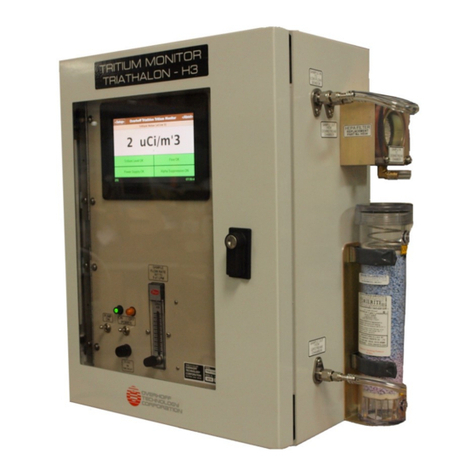
7
CAUTION: Do not unscrew a collecting vial while the pump is on. This could cause a sudden change
in pressure or vacuum in certain parts of the pneumatic system which could cause liquid
to be drawn from one of the other vials into the piping. Always make sure the pump is
turned off and bubbling has completely stopped before removing a collection vial.
4.3. IMPORTANT PRECAUTIONS FOR PASSIVE SAMPLER, MODEL TASC
The collection liquid can move accidentally into parts of the system where it should not
be. This is one thing that must be prevented, because the sample transport system is
designed only for moving air, not liquid. It is extremely important that the collection liquid
remain in the vials.
Take only the following precautions:
a. DO NOT TIP THE INSTRUMENT ON ITS SIDE WHENEVER THERE IS
COLLECTING LIQUID IN THE VIALS.
b. DO NOT TRANSPORT THE INSTRUMENT WITH COLLECTION LIQUID IN THE
VIALS.
c. DO NOT UNSCREW A VIAL WHILE THE PUMP IS RUNNING. Always make sure
the pump is off and bubbling has completely stopped before removing a collecting
vial. Wait two minutes after the pump has stopped.
d. If a hose is connected to the sample in hose barb, be certain that it does not get
plugged or pinched closed, this will be indicated by the LOW FLOW indicator light
on the front panel, and can cause a vacuum to form in the filter housing, thus
drawing liquid into it, if the pump is stopped. In this particular situation, it is very
important to RELIEVE THE VACUUM CONDITION BY REMOVING THE HOSE ON
THE SAMPLE IN HOSE BARB PRIOR TO SWITCHING THE INSTRUMENT PUMP
OFF.
e. The mass flow rate calibration can be verified with the vials empty or full of
collecting liquid. The mass flow display on the front panel of the TASC shall indicate
100±3 scc/min.
f. The liquid level first vial of the three in the HT section may increase. This is caused
by condensate from the oxidizer when heating up from a cold start. Adjust the liquid
level accordingly or run the system without liquid for the warm up phase.
g. The recommended collection medium for C14 is Acscarite™(sodium hydroxide). It
is very corrosive; refer to MSDS at the end of this manual. If there is moisture in the
sample passing through the Ascarite, it will react with it and cause it to partially
dissolve turning it into a paste-like consistency, at which point the sample flow will
be obstructed, and the collection system will cease to operate. Four desiccant
columns connected in series will assure complete removal of the moisture in the
sample prior to entering the C14 collection tube. This should be sufficient quantity of
material to last for the duration of a week long sampling period. Attach the
cartridges to the front of the separate C14 panel by means of plastic hose. The
sample air travels from your left to right when viewing the front panel of the TASC.
The sample air should first move through the drier cartridges, then through the
ASCARITE cartridge. Start the TASC pump and check the flow meter indication at
100±3 scc/min to ensure that the system is free from leaks. Now the TASC is ready to
begin another sample collection sequence. REMEMBER TO RESET THE TIMER.





























